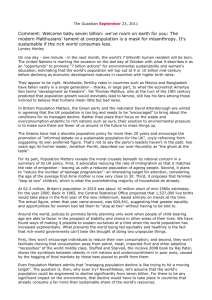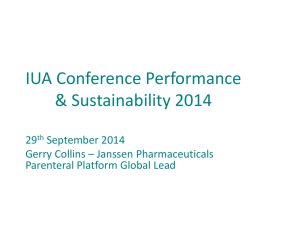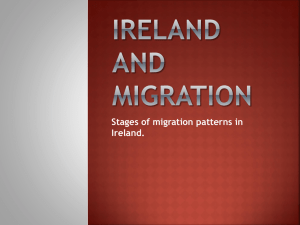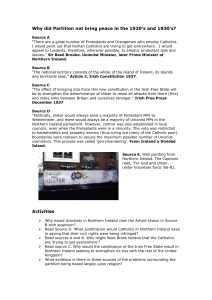Task 7 - Glens Of Antrim Historical Society
advertisement
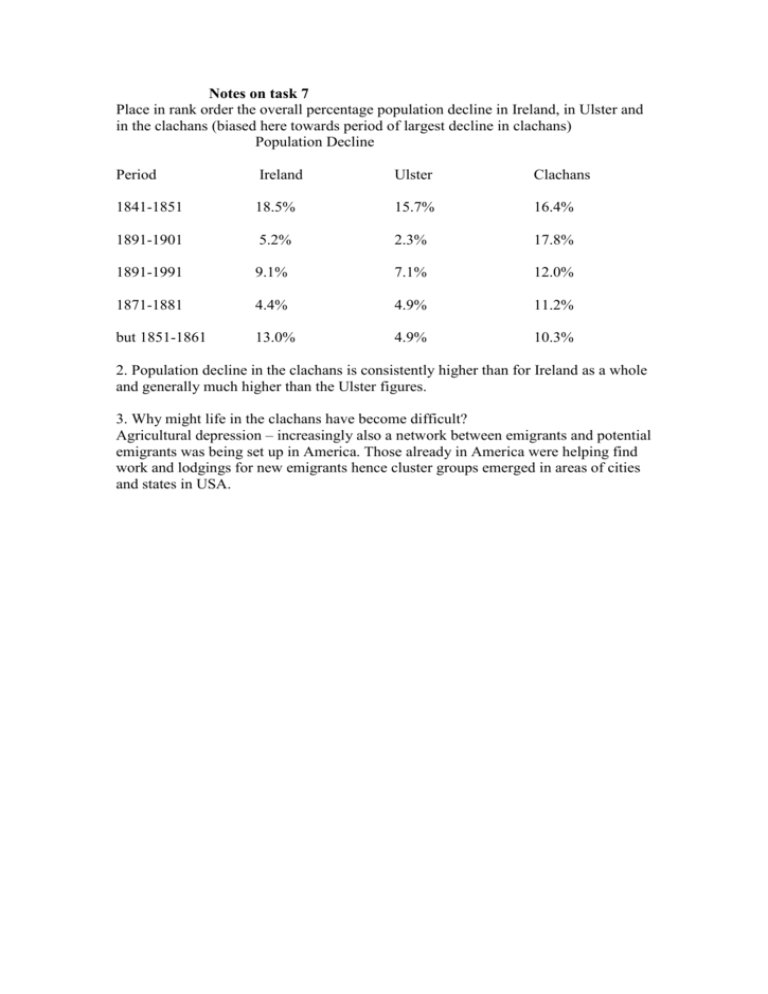
Notes on task 7 Place in rank order the overall percentage population decline in Ireland, in Ulster and in the clachans (biased here towards period of largest decline in clachans) Population Decline Period Ireland Ulster Clachans 1841-1851 18.5% 15.7% 16.4% 1891-1901 5.2% 2.3% 17.8% 1891-1991 9.1% 7.1% 12.0% 1871-1881 4.4% 4.9% 11.2% but 1851-1861 13.0% 4.9% 10.3% 2. Population decline in the clachans is consistently higher than for Ireland as a whole and generally much higher than the Ulster figures. 3. Why might life in the clachans have become difficult? Agricultural depression – increasingly also a network between emigrants and potential emigrants was being set up in America. Those already in America were helping find work and lodgings for new emigrants hence cluster groups emerged in areas of cities and states in USA. Demographic Decline in Clachans 1841-1926 (Population Data / Number of Houses) Glen 1841 1851 1861 1871 1881 1891 1901 1911 1926 Glenariff 322/56 332/60 302/57 307/57 268/47 207/44 187/42 171/36 141/35 Glendun 635/101 534/87 484/91 446/89 375/78 316/72 244/61 234/56 191/52 Glenarm 352/59 277/52 303/57 258/46 241/43 244/40 203/35 185/33 132/29 Glenballyeamon 87/15 75/10 55/10 59/11 58/12 40/9 33/7 27/7 40/13 Glencorp 154/25 110/20 108/24 114/25 110/24 70/16 65/16 38/15 21/9 Glenaan 135/24 140/26 127/26 107/20 107/23 92/20 87/19 76/18 40/12 1058/192 864/152 706/141 683/136 563/114 515/104 409/98 436/97 347/80 Glencloy 290/47 232/46 230/44 208/42 211/46 199/44 173/36 189/41 125/31 Glentaisie 161/28 131/25 115/19 93/23 90/21 81/18 47/13 50/13 62/13 Rathlin 128/22 84/13 64/10 55/11 47/9 57/10 48/9 53/11 37/7 3322/569 2779/491 2494/479 2330/460 2070/417 1821/377 1496/336 1459/327 1136/278 16.35/13.7 10.26/2.44 6.57/3.97 11.16/9.35 12.03/9.59 17.84/10.87 2.47/2.67 Glenshesk TOTALS % DECLINE Population decline by glen The population percentage decline by glen and for individual clachans shown below is based on the difference between the 1841 and 1926 population data. Glenariff 56.2% Glendun 69.92% Glenarm 62.50% Glenballyeamon 54.02% Glencorp 86.36% Glenaan 70.37% Glenshesk 67.20% Glencloy 56.90% Glentaisie 61.49% Rathlin 71.09% Greatest population decline by glen 1. Glencorp 86.36% 2. Rathlin 71.09% 3. Glenaan 70.37% 4. Glendun 69.92% Please note: the census data for each individual clachan held on the Clachan Project’s database might be inserted at this point. Alternatively, and especially if the insertion of the individual clachan data would result in too much information, it may well be sufficient to proceed as set out below, but add a note here that it is possible to investigate all of the population and house patterns in respect of individual clachans 1841-1926 by accessing the main Glens of Antrim Historical Society Clachan Project database at www.antrimhistory.net Analysis by individual clachan Greatest population decline by individual clachan 1841-1926 1. Carnasheeran and Drumnacur (Glencorp) 100% 3. Ballyteerim (Glendun) 95.12% 4. Feystown (Glenarm) 91.67% 5. Knockban (Glenaan) 88.89% and 5. Unshinagh (Glencloy) 88.89% 6. Broom-beg (Glentaisie) 85.94% 7. Tromra (Glencorp) 84.42% 8. Dunouragan (Glendun) 83.33% 9. Aughnasillagh (Glendun) 82.76% Smallest population decline 1. Carnahagh (Glenballyeamon) 3.70% 2. Aghalum (Glencloy) 18% 3. Callisnagh (Glendun) 37.78% 4. Broom-more (Glentaisie) 42.86% The percentage decline in population for all of the clachans in the Glens of Antrim and Rathlin Island between 1841 and 1926 was -65.80%. In contrast, the national and provincial data for population decline 1841 to 1926 was: Ireland -48.27% Ulster -33.72% Section 8 The Glens of Antrim Historical Society Oral History Project: reflections on emigration Some of the interviews recorded as part of the Society’s Oral History Project provide interesting insights into the process of emigration and decline which affected adversely the Glens area generally and the clachans in particular. The three interviews below help to explain when and why the people left. Annie McKillop (Knockban) “There must have been something happening and times was maybe buzzing in America at that time, or something, because there’s an awful lot went to America about 1911 or 1912. There was a brother to Captain Jimmy McKeegan, Patrick McKeegan. He was a Captain as well, and he went to America with the whole family in 1912. At the same time there was another man, a cousin, Alex McCambridge that lived above in Knockban there, there’s only wallsteads in it now, and he went too with his family to America. He was a cousin to Patrick McKeegan. They were first cousins. And then there was another family, John McAllister’s. A wee bit further down the lane there’s a wee house, and that’s where this man John McAllister and his wife and family went from there to America. That was three families that went inside of a very short time.” Mairead Kane (Glendun) “I think it was just its ruggedness, its quietness. There was no work but it was very isolated and it wasn’t very profitable to work really, you know. The land in Glendun would’ve been very rugged, with a lot of rocks and very unarable land and it didn’t really entice young ones to stay. There wasn’t really a livelihood for young people and I would say that’s why they just all drifted away, mainly to America, and then they just didn’t come back. A family living today couldn’t live on what we lived on in Glendun, you know, when I was growing up. I don’t think it was a sudden exodus out of the Glen. No, I think it was gradual but then a lot of people had gone that I never knew … They maybe came back an odd time to visit. Then, of course, there were families maybe never married. That was another cause of the decline in population, no children.” James McHenry (Torr Head) “I didn’t hear my parents talking about the potato blight. There were relatives of the McHenrys of Torr that escaped in the coffin ships … There was a whole lot of people went away in the coffin ships. There must have been one of the McHenrys from Torr Head went. There was a man called at my door here about four years ago. Wasn’t he from New Zealand and says he, “My name’s Tony McHenry … you’re McHenry too.” I suppose he looked up the name. Says he, “You were born in Torr Head?” Says I, “I was.” “My ancestors were born in Torr”, says he, “but they got away in coffin ships at the time of the Famine.” And he has a whole lot of letters with him that would confirm it, that were got from Torr Head at the time of the Famine, when he went to New Zealand.” Section 9 Migration and economic change c1845-c1911 The Clachan Project identified three key factors to explain the decline of the clachans. Emigration: substantial emigration after 1860 of many sons and daughters, and also of whole families. In the case of Straid clachan, for example, there was a tradition of migration to Greenpoint, an area of Brooklyn in the city of New York, where many immigrants from the Glens settled. The number of unmarried people, especially men aged between 20 and 39. This resulted in significant problems later, with elderly unmarried men dying and leaving their farms to relatives who often lived elsewhere. The consolidation of land through the decline of the rundale system of land holding. This process began in the late 19th century, continued into the 20th century, and accelerated the decline of the clachans. For instance, in the case of Coolnagappoge clachan, the decline was attributed to poor harvests; poor land quality; limited arable land; the inefficiency of the rundale system with its scattered landholdings; outdated farming practices; and the threat of eviction. The Atlas of Irish History also noted the importance of the consolidation of land into bigger farms. Due to migration between 1841 and 1911, the numbers of farms in County Antrim of more than 15 acres increased substantially as smaller uneconomical farms were abandoned and the land was consolidated into larger units, as is demonstrated below. Land holdings over 15 acres in County Antrim 1841 1911 c20-29% c50-59% The rest of this section centres on emigration from Ireland after 1845, and on the reasons for such large-scale emigration. This evidence is drawn from all of Ireland and not just from County Antrim, but it also provides a clear context against which changes in the clachans in the Glens and in Rathlin Island can be better understood. The implications of such large-scale emigration for life in the clachans are explored further in the classroom activities suggested in Section 12. Roy Foster, a leading Irish academic historian has pointed out that “Emigration is the great fact of Irish social history from the early nineteenth century … In the nineteenth century, however, the stream became a flood.” He noted that some 1 to 1.5 million people emigrated from Ireland in the 30 years before the Famine, but between 1845 and 1870, at least a further 3 million emigrated. Foster also investigated emigration data for 1851-1871, 1871-1891 and 1891-1911. The results show that a very high percentage of emigrants came from County Antrim. Emigrants 1851-1871 (as a percentage of the population in 1851) Antrim: 52% (the highest percentage from any county in Ireland) Limerick: 42% Cork: 41% Other Ulster counties by contrast: Tyrone : 26% Armagh : 24% Londonderry: 23% Down Donegal : 23% : 20% Emigrants 1871-1891 (as a percentage of the population in 1871) Antrim: 43% (still the highest percentage from any county in Ireland) Kerry : 40% Emigrants 1891-1911 (as a percentage of the population in 1891) Kerry: 35% (highest percentage from any county in Ireland) Mayo: 32% Antrim: 21% (9th position) The Atlas of Irish History (1997) confirms this significant emigration from County Antrim during the years 1851-1911. It notes that, across these 61 years, the highest percentage of emigrants came from County Cork, and second greatest came from County Antrim. Provincial emigration 1851-1911 Munster 1,460,032 Ulster 1,192,177 Leinster 726,389 Connacht 702,215 Main counties of residence of Irish emigrants in 1901 USA : 64% GB : 25% Australia: 7% Canada : 4% In his book, Landlord and Tenant in Nineteenth Century Ireland (1973), James Donnelly, an American historian, has identified key factors and periods which help to explain the increase in emigration during the second half of the 19th century. He notes, in particular, the key issues below. The severe agricultural depression 1859 to1864, followed by the good harvests and the excellent prices for livestock and butter 1870 to 1876, even though the potato crop failed almost totally in 1872. A second period of agricultural and economic decline in the late 1870s changed everything as bad weather, poor harvests and low prices damaged the whole rural economy. Donnelly highlighted the disastrous grain and potato harvest in 1877, and the especially bad year of 1879. 1879 was a disastrous year with incessant rain and cold weather. Potato blight reappeared and potato production fell by 75%. The harvest generally was very bad and farmers had to endure falling prices due to the entry of American grain and beef on to the British market. The impact was most damaging on small farms with a great dependence on tillage, the potato, and on the seasonal migration of farm workers to work in the English and Scottish harvests. Due to an economic recession in England at the same time, migrant farm workers from Ireland found it difficult to obtain temporary work in England. The winter of 1879-1880 was especially severe and brought about a period of acute distress. For many small farmers, the year between1879 and1881 saw an increase in debt and insolvency. Throughout the 1880s, agricultural prices and profits continued to fall. This led inevitably to the next major agricultural crisis of 1886 to1887. Section 10 All-Ireland Census and Emigration Data: a comparative study i) Census/population data: Ireland 1841: 8,175, 124 … +5.25% above 1831 census return 1851: 6,663, 385 … -18.49% down on 1841 return 1861: 5,798,967 … -12.97% down on 1851 return 1871: 5,412,377 … -6.67% down on 1861 return 1881: 5,174,836 … -4.39% down on 1871 return 1891: 4,704,550 … -9.08% down on 1881 return 1901: 4,458,775 … -5.23% down on 1891 return 1911: 4,390,219 … -1.54% down on 1901 return 1926: 4,228,553 Overall numerical decline in population 1841-1926: 3,946,571 persons Overall percentage decline: -48.27% ii) Population data: Ulster (rounded up) 1841: 2.386,400 1851: 2,011,900 … -15.69% down on 1841 return 1861: 1,914,200 … -4.86% down on 1851 return 1871: 1,833,200 … -4.23% down on 1861 return 1881: 1,743,100 … -4.92% down on 1871 return 1891: 1,619,800 … -7.07% down on 1881 return 1901: 1,582,800 … -2.28% down on 1891 return 1911: 1,581,700 … -0.07% down on 1901 return Overall numerical decline in population 1841-1911: 804,700 persons Overall percentage decline: -33.72% iii) Emigration data: Ireland The emigration data below illustrates clearly how emigration rose when there were economic difficulties in Ireland. For example, emigration increased substantially during the famine years of 1845-1850 and the following year. The data also shows that the agricultural crises of 1859-1864, 1879-1881 and 18861887 were accompanied by an increase in emigration. The implications of all of this for life in the clachans are explored further in the classroom activities part of Section 12. 1845: 74,969 1847: 215,444 1849: 214,425 1851: 249,721 1863: 117,229 1864: 114,169 1865: 101,497 1879: 47,065 1880: 95,517 1881: 78,417 1882: 89,136 1883: 108,724 1886: 63,135 1887: 82,923 1888: 78,684 1889: 70,477 1891: 59,623 1900: 45,288 1911: 30,573 iv) The following data reflects population decline across all of Ireland, in the province of Ulster, and finally, in the clachans. The patterns, and issues arising, are explored further in Section 12 (suggestions for classroom work). Decade Ending Ireland Ulster Clachans 1851 -18.5% -15.7% -16.4% 1861 -13.0% -4.9% -10.3% 1871 -6.7% -4.2% -6.6% 1881 -4.4% -4.9% -11.2% 1891 -9.1% -7.1% -12.0% 1901 Section 11 -5.2% -2.3% -17.8% Conclusion This CD-Rom has explored life in the clachans of the Glens of Antrim and Rathlin Island. Some 70% are still lived in, though there are fewer people and fewer occupied houses. The years since the Great Famine of 1845-1850 brought about great changes to life in the clachans. Many of the people who once lived in them departed in search of a better life in the United States of America, or elsewhere in Ireland, or in Great Britain, leaving their homes in the Glens and in Rathlin to crumble into ruin. This CD-Rom has also explored wider social and economic issues from 1841 to 1926 relating to Ireland as a whole and has investigated how far these matters affected adversely life in the clachans. Particular attention has been given to population decline and to emigration to determine how these processes changed forever the history of Ireland, and life in the clachans. The Clachan Project has allowed school children to recapture a way of life now gone. Memories of the clachans, the people, and their traditions, have been captured by teachers and by their pupils. Stories of long ago have been recorded, and tumbled ruins have been looked at in a new way as memorials to a hardy people who once lived in the Glens and in Rathlin, who earned a living there, and whose traditions are worth remembering. Section 12 Classroom activities and additional information for teachers The activities below are offered as tasks for pupils in primary 7 and in KS3 and vary in the level of challenge. Those suggested for Sections 4 and 5 are comprehensive and interpretive activities based on the information provided in those sections above. The tasks suggested for Section 6 (involving family and other patterns based on the 1901 Census in 9 clachans) are more demanding, but should be within the competence of primary 7 and KS3 pupils of average or better ability. The tasks involve understanding and manipulating statistical (Census) data, and issues arising. The activities offered for Sections 7 and 10 are challenging but should permit able children in Primary 7 and in KS3 to investigate how national factors and trends help explain local events. The activities involve consideration of census and other data and draw upon the pupils’ analytical and evaluative skills, as well as their data-handing and mathematical competences. Alternatively, teachers might prefer, in a whole-class context, to introduce all of the pupils to these wider national issues. The tasks suggested for Section 9 are also challenging and examine historians’ views about emigration, and those social and economic factors which underpin it. These tasks might also be explored through group work with able pupils, or reviewed by the teacher with all pupils in a structured whole-class setting. Section 4 Life in a Clachan: evidence from the school projects Classroom activities based on the primary school reports about life in the clachans, and on interviews in relation to Knockban and Straidkilly clachans 1. According to Natasha, to what extent were the clachans linked to particular families, and how did this create problems which later led to people emigrating? 2. According to Danni and Meghan, how were the people allocated land to farm, what type of animals did they keep, and how did they improve the quality of their crops? 3. In Paul and Eoin’s account of their visit to Gortaghragan clachan, what information were they given which explained how the people in the clachan helped their neighbours? 4. In the interview about Knockban held with Mr Sharpe, what did he mean when he reported that the people living in Knockban were “very self-sufficient”? 5. How did Mr Sharpe explain the decline of Knockban clachan? 6. According to the interview with Mr McGavock about Straidkilly clachan, what was life like in Straidkilly when he was growing up? 7. Based on Meta McKillop’s interview on Straidkilly about 1940, how different was life then compared to life now? Section 5 The 19th Century Ordnance Survey Memoirs of Ireland: the Glens of Antrim and the North Antrim Coast Classroom activities based on the Ordnance Survey Memoirs for Ardclinis, Layd, Tickmacrevan and Culfeightrim 1. Describe the range of crops grown, the methods used to improve the yield, the food of the people, and the fuel they used. 2. What did their houses look like? 3. How did the people earn money to pay their rent, and which forms of employment were available to them? 4. Which occupations, listed in the 1830 survey of Glenarm, would you not expect to find in Glenarm now? 5. What language, or languages, did the people speak in the 1830s? 6. How did the people dress? 7. At approximately what age did they marry, and what was the average number in a family? 8. What amusements did the people have? 9. What did the Ordnance Survey Memoirs report about emigration from the area? 10. According to the Memoirs, how had the appearance of the area changed significantly in the years prior to 1830? Section 6 The 1901 Census: a study of 9 clachans 1. Based on the information provided in the 1901 Census, list the occupations of those who lived in the 9 clachans. Information for teachers: the occupational patterns in the Census data indicate that the inhabitants were mostly farmers - some 58% of the heads of families were farmers. In contrast, the overview paper prepared by the Glens of Antrim Historical Society concluded that a survey of all of the 1901 clachan Census returns indicated that some 63% of the heads of families were farmers. In the 9 clachans considered here, other occupations recorded in the Census include a seamstress; agricultural labourers; limestone quarrymen; sailors; a domestic butler; coastguards; a flax cleaner; a scutchmill worker; a gamekeeper; fishermen; and carpenters. 2. According to the information in the Census, how accurate is it to state that the family groupings recorded in the 9 clachans often consisted of extended families and their servants? An extended family group involves combinations of father, mother, children, grandparents, as well as other relatives. Information for teachers: extended families, as defined above, and servants, characterise the family groupings in the 9 clachans. 3. The Census data for 1901 lists 39 families (132 people) in the 9 clachans. What was the average family size (children, including adult children) and identify the number of children in the smallest families and the number of children in the largest family. Information for teachers: The average family size was 3.4 and the number of children ranged from 1 in the smallest families to 9 in the largest. 4. Identify any unusual family patterns recorded in the Census data for 1901, especially adults or children living in the clachans who were born in counties other than County Antrim, elsewhere in the British Isles, or in more distant lands. Information for teachers : unusual patterns contained in the Census data included several children born in England (Ballygill/Brockley clachans on Rathlin Island); 1 child born in Australia (Straidkilly clachan); a significant number of coastguard families with parents born in England and children born outside County Antrim (East Torr clachan); and 2 orphans from Belfast living with a family in Carey Mill clachan. 5. Based on the information recorded in the Census for 1901, what percentage of people aged 25 or over were unmarried? 6. Of those who were unmarried, what was the percentage of unmarried people who were aged between a) 25 to 39 years; b) 40 to 49 years; and c) 50 or more years? Information for teachers: Marital status: a significant number of those living in the 9 clachans were unmarried. Some 60 out of a total of 148 people aged 25 years and over were unmarried (41%). Of this unmarried group, some 29 out of 60 (48%) were aged 25 to 39 years; some 10 out of 60 (17%) were aged 40 to 49 years; and some 21 out of 60 (35%) were aged 50 years and over. 7. As a significant percentage was unmarried, what problems might this have caused for life in the clachans following the deaths of these unmarried people? Information for teachers: the overview paper prepared by the Glens of Antrim Historical Society noted that many men remained unmarried. The paper also noted that an inevitable outcome of this type of marriage pattern was that elderly unmarried people died leaving their farms to relatives from elsewhere in the Glens, or in Britain, the USA or Australia. These relatives often decided not to live on the farms and gradually the unoccupied houses fell into disrepair and ruin. Section 7 The Clachan Project Database: population and house patterns 1841-1926 The task suggested below is a data-handling exercise linked to census data. It investigates the changes in the population and occupied houses in the clachans over a period of 85 years. The task is linked to the table in Section 7 entitled Demographic Decline in Clachans 1841-1926. 1. Based on the percentage rate of decline per decade, as set out in the final line of the table, identify and rank order the 5 decades when the decline in population and house occupation was at its greatest. Section 8 The Glens of Antrim Historical Society Oral History Project: reflections on emigration 1. Emigration often involved younger members of a family. How did Annie McKillop’s memories of emigration from Knockban about 1911-12 differ from that pattern? 2. List the 4 main reasons for emigration from Glendun suggested in Mairead Kane’s interview. 3. James McHenry’s interview centres on memories of his relatives migrating to New Zealand. Based on what you know of the Great Irish Famine and migration from Ireland, is his reference to “coffin ships” and New Zealand an accurate comment on migration at that time? Section 9 Migration and Economic Change in Ireland: c1845-c1911 1. List the 3 main reasons identified by the Clachan Project for the decline of the clachans. 2. According to the historian, Roy Foster, what was important about emigration from County Antrim between 1851 and 1911? 3. According to the historian, James Donnelly, what were some of the main reasons for the increase in emigration from Ireland from 1859 to 1887? Section 10 All-Ireland Census and Emigration data: a comparative study The tasks below examine historians’ views about population and emigration, and also consider the social and economic factors which underpin both. In particular, the tasks explore how national factors and trends help to explain local events 1. Based on the data given at the end of Section 7, place in rank order the overall percentage population decline in Ireland, in Ulster, and in the clachans. 2. Based on the data given in the table below, which shows the decline in population for each decade from 1841 and 1901, how did population decline in the clachans compare with that in a) Ireland as a whole and b) in Ulster? 3. Given the data below for 1881 to 1901, why might life in the clachans have become difficult? Decade Ending Ireland Ulster Clachans 1851 -18.5% -15.7% -16.4% 1861 -13.0% -4.9% -10.3% 1871 -6.7% -4.2% -6.6% 1881 -4.4% -4.9% -11.2% 1891 -9.1% -7.1% -12.0% 1901 -5.2% -2.3% -17.8%
